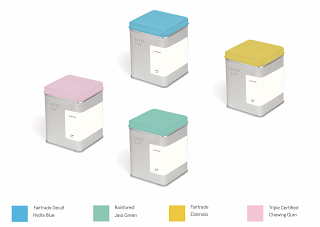OUGD503 - Studio Brief 1/Individual Practice
Production: Proof Mock Up Feedback
The response received towards the proof mock up was very encouraging as all the people asked for feedback commented on the quality of the resolution. When questioned about the sandblasting and if it was appropriate technique every participant questioned said they liked the effect it produced, comments regarding the sandblasting included; I really like how you've utilised the properties of the metal to give it this nice textured effect' and 'I love the lid, I think its so effective and will stand out, I personally think the front logo could be little bit smaller as it feel a tad quashed but thats up to you'. I agreed the grand cafe logo looked rather large on the front however this boldly promotes the brand and will ensure it is rememberable to the consumer.
There were no advised changed to the label design, the feedback received regarding the label was largely positive for example 'I like the simple design, it goes well with the metal not being too out there' 'the coloured lines make the label much more contemporary, I like the minimal colour palette as its subtle but fun and very effective' More general comments on the packaging as a whole included 'It looks quality, not like the cheap plastic bag that was used before, this gives a real sense of something bit more special' and 'I think the tins a really good idea, its re-useable, protective and looks really cool, good job'. From this feedback I will trial a smaller logo and evaluate if this would be more appropriate before expanding the label designs to the three other blends which would leave me feeling confident to produce the final packaging resolutions.
The response received towards the proof mock up was very encouraging as all the people asked for feedback commented on the quality of the resolution. When questioned about the sandblasting and if it was appropriate technique every participant questioned said they liked the effect it produced, comments regarding the sandblasting included; I really like how you've utilised the properties of the metal to give it this nice textured effect' and 'I love the lid, I think its so effective and will stand out, I personally think the front logo could be little bit smaller as it feel a tad quashed but thats up to you'. I agreed the grand cafe logo looked rather large on the front however this boldly promotes the brand and will ensure it is rememberable to the consumer.
There were no advised changed to the label design, the feedback received regarding the label was largely positive for example 'I like the simple design, it goes well with the metal not being too out there' 'the coloured lines make the label much more contemporary, I like the minimal colour palette as its subtle but fun and very effective' More general comments on the packaging as a whole included 'It looks quality, not like the cheap plastic bag that was used before, this gives a real sense of something bit more special' and 'I think the tins a really good idea, its re-useable, protective and looks really cool, good job'. From this feedback I will trial a smaller logo and evaluate if this would be more appropriate before expanding the label designs to the three other blends which would leave me feeling confident to produce the final packaging resolutions.
















































